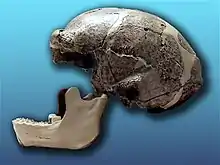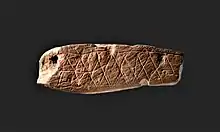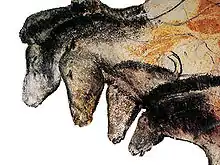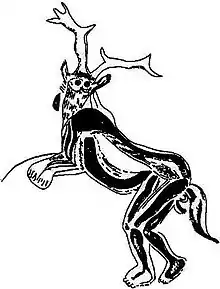Paleolithic religion
Paleolithic religions are a set of spiritual beliefs thought to have appeared during the Paleolithic time period. Paleoanthropologists Andre Leroi-Gourhan and Annette Michelson believe religious behaviour emerged by the Upper Paleolithic, before 30,000 years ago at the latest,[1] but behavioral patterns such as burial rites that one might characterize as religious — or as ancestral to religious behaviour — reach back into the Middle Paleolithic, as early as 300,000 years ago, coinciding with the first appearance of Homo neanderthalensis and possibly Homo naledi.

| The Paleolithic |
|---|
| ↑ Pliocene (before Homo) |
| ↓ Mesolithic |
Religious behavior is one of the hallmarks of behavioral modernity. There are several theories as to the moment when this modernity emerged. One theory links these innovations to a cultural revolution among the early modern humans, which coincided with their arrival to Europe 40 000 years ago. A variant of this model sees behavioral modernity as occurring gradually, beginning with the Middle Stone Age. According to a third theory, characteristics that define behavioral modernity are not unique to the homo sapiens, but arose over a long period of time, among different human types, including neanderthals.[2] It has even been postuplated that homo erectus had some form of language and symbolism.[3]
Lower Paleolithic
Skull cult

The oldest reported ritual acts relate to the Peking Man found in Zhoukoudian. The original researchers believed it to be the oldest recorded victim of a ritual killing in the world. One of the hypotheses for the injuries on the skull was removal of the brain for consumption, an early form of the cult of the skull.[4] Actions connected to a secondary burial could also explain the injuries. In such a case, the body would've been left to rot in a protected place outside of the cave, after which the skull would've been removed, cleaned and carried to the cave.[5] Similar rituals were found in the Sulawesi natives, before their adoption of Islam.[6] All theories related to the Peking Man remain conjecture, as no follow-up research is possible due to the remains being lost in the course of the Second World War.[7]
Possible ritual behavior was also noted on the Bodo cranium, found in Bodo D'ar, in the Awash River valley of Ethiopia, and dated to 600 000 BP. Its' anatomy suggests a hominid with characteristic of both the homo heidelbergensis and the homo erectus. The skull shows evidence of post mortem scratches caused by defleshing with stone tools.[8]
Pigment use
Red ochre has been found in sites associated with the homo erectus as well, however, the finds are rare and no evidence of their application has been noted. The exception to this is the Venus of Tan-Tan, dated to 300 000 BP, which has traces of red pigment on it, suggestive of symbolic value, as well as traces of human modification.[9] Slightly younger is the Venus of Berekhat Ram, dated to 270 000 BP, which likewise has traces of modification by stone tools.[10]
Middle Paleolithic
Pigment use

According to André Leroi-Gourhan, pigment use of evidence of spiritual behavior, as its' use serves no material purpose.[11] A great number of pigments has been found in both Neanderthals and early modern human sites. Particularly interesting is a painted mammoth molar from Tata, Hungary, associated with Neanderthals. The main side of the mammoth molar was painted in red ochre, while the back side of it showed heavy traces of use.[12] In Blombos cave, two ochre fragments have been found, which bear engraved geometric patterns.[13]
Burials
Graves are the clearest signs of spiritual behavior, as it shows delineation between the world of the living and the world of the dead. Most often, archaeologists will seek to find some form of grave goods, pigment use, or other forms of symbolic behavior to differentiate from burials motivated by other reasons, such as hygiene.[14] Examples of such burials are La Chapelle-aux-Saints 1,[15] Le Regourdou,[16] Shanidar 4,[17] and Teshik-Tash 1,[18] among others.
Ritual cannibalism
Eating the flesh of deceased in order to inherit their qualities or honor them is a practice that has been noted in numerous contemporary societies, such as the Wariʼ people,[19] and evidence of it may be found in middle Paleolithic as well.
Ritual cannibalism has been suggested for the Krapina Neanderthals, based on three factors: mixing of animals and human skeletal remains, breaking of long bones (in order to access the marrow), and the fact that not a single skull was found in a non-broken state. Although controversial, the idea of possible cannibalism was supported by a number of subsequent scientists, such as Mirko Malez, H. Ulrich and K. Tomić Karlović.[20] Neanderthal cannibalism has also been noted in Vindija cave,[21] Moula-Guercy,[22] and possibly in Combe Grenal[23] and Hortus.[24]
Ritual cannibalism has been noted among the early modern humans of the Klasies River Caves, who consumed other anatomically modern humans. Evidence of it has been found at the Les Rois site as well, where early modern humans consumed the flesh of neanderthals.[25]
Skull cult
The idea of a skull cult among the prehistoric people was popular throughout the 20th century, however, subsequent research and re-analysis disproved most of such theories.[26]
The frontal bone of the Krapina 3 cranium has 35 incisions, which cannot be explained through cannibalism, but may be the result of natural processes.[27] At Vindija Cave, only skull and mandible fragments were found, which Mirko Malez has interpreted as purposeful selection. Cuts and incisions seen on them may be a consequence of defleshing.[28]
Bear cult
Numerous cave bear skulls were found alongside evidence of human habitation in Middle Paleolithic caves, which lead scientists to assume the existence of a bear cult. The bones were most often of cave bears and more rarely of brown bears.[29] The skulls were place in a cave niche or other prominent places, presumably for worship. Aside from human activity, the position can also be explained through animal activity or natural processes.[30]
Upper Paleolithic
Upper Paleolithic began about 40 000 BP in Europe, and slightly earlier in Africa and the Levant. Use of pigment and the practice of burial extends into this period, with the addition of cave art and portable art. The upper paleolithic is the prehistoric period during which the symbolic and modern behavior is fully developed.[31]
Cave art
According to Richard Klein, the art and burial of the upper paleolithic is the first clear and undeniable proof of an ideological system. The art can be divided into two types: the cave art such as paintings, engravings and reliefs on stone walls, and portable art.[26]

Although first evidence of it was discovered in Europe, the earliest cave art was created in Australia and southeast Asia.[32] The oldest cave art so far discovered, is from the island of Sulawesi in Indonesia, dated to 45 500 BP, depicting a rotund pig and hand traces.[33] Famous examples of cave art include the oldest figurative depictions in Europe found in Chauvet cave, Romuald’s Cave and Fumane cave, while the most famous examples are found in the cave of Altamira and Lascaux. Cave art isn't confined to Europe, as examples of it can be found in Australia and Asia as well. Non-painted art exists as well, i.e. the Venus of Laussel which was carved into the limestone wall.[34]
The idea of art for art's sake, which was held by some archaeologists in the past,[35] has today largely been abandoned.[36] Totemism was another explanation, which was later abandoned. If the animals were totems, they wouldn't have been depicted as injured. Furthermore, there aren't gatherings of animals around any specific depictions, as would have been the case if they were totems. The art may have been part of a ritual to increase hunting success. Through the depictions of these animals, the prehistorc man would have attempted to gain power over them. Another explanation is that the magic could have been aimed at increasing the number of the depicted animals, which were vital for the survival of the upper paleolithic humans.[37]
Andre Leroi-Gourhan saw these depictions as a reflection of the natural and supernatural ordering of the world through sexual symbolism. Certain animals (i.e. the bison) were connected to female values and other to male values (i.e. the horse). These interpretations are based on subjective interpretations of modern humans, which don't necessarily reflect the worldviews of the prehistoric peoples.[38]

Shamanism is another popular explanation. The caves would as such represent entrances to the spiritual realm in which one can communicate with spiritual beings. Many of the animals depicted in cave art aren't depicted as hunted, as part of hunting magic. Their depictions would serve to give the shaman their strength and traits to help him during his hallucination, when he would communicate with the supernatural powers. The half-animal, half-man depictions, as for example the Trois-Frères sorcerer, would represent the Lord of Animals.[37] Depictions of women in cave art suggests their participation in these rituals,[39] perhaps through dance accompanied by music.[40]
Portable art
Kozlowski saw animal carvings as connected to hunting magic, aimed at increasing success.[39] Especially interesting are the Venus figurines. They are figurines of women, with accentuated curves, either naked or partly dressed, wearing necklaces, bracelets or tattoos, and without a face. They are present from the Pyrenees to the Don river. Such wide geographic distribution imply the existence of a superregional, shared ideological system.[41]
They could have represented fertility goddesses, connected to giving and protecting life, as well as with death and rebirth.[42] Profane explanations see these figurines as pornography,[43] auto-portraits[44] or depictions of important women in the tribe. They may have symbolized the hope for a prosperous and well-nourished communities.[45]
Burials and pigment use
Based on the grave goods found beside the deceased, upper paleolithic burials are undoubtedly evidence of spirituality and religiousness. Pigments of various kinds are found in great amounts in various sites across Europe. The graves best illustrating this are described below:
- Grimaldi man - triple burial of an adult man, in-between two adolescents of male and female sex. They were covered in ochre and wearing seashell, tooth and bone ornaments. The grave goods appear in the form of various stone tools. The man in the middle was laying on a "pillow" of bison bones.[46]
- Dolní Věstonice II - triple burial, all three skulls and the pelvis of the middle person were covered in red ochre. The left and right person were men, while the middle person was a gracile man with abnormalities.[47]
- Brno II - a rich male burial. An ivory sculpture made of ivory was found, as well as over 600 ornaments made of tertiary shell, stone and ivory. Two large pierced silicon discs suggest the man buried here was a shaman.[46]
- Sungir - five burials, with two child burials, a boy and a girl. The boy was buried with 4903 ornaments, which were likely attached to his clothes, 250 fox canines, a male femur covered in red ochre, and two small animal statuetes. The girl was buried with 5274 ornaments. It would have taken over 7000 working hours to produce all these grave goods. A male burial with nearly the same amount of grave goods was found as well, with 2000 working hours being required for the production of his grave goods.[48]
See also
References
- Andre Leroi-Gourhan and Annette Michelson, "The Religion of the Caves: Magic or Metaphysics?", The MIT Press, Vol, 37, October 1986, pp. 6-17. "cave art born 30,000 years before our era ... would appear to have developed simultaneously with the first explicit manifestations of concern with the supernatural." (p. 6)
- d'Errico, Francesco (August 2003). "The Invisible Frontier. A Multiple Species Model for the Origin of Behavioral Modernity" (PDF). Evolutionary Anthropology Issues News and Reviews. 12 (4): 188–189. doi:10.1002/evan.10113. Retrieved 24 January 2021.
- Barham, Lawrence; Everett, Daniel (2020). "Semiotics and the Origin of Language in the Lower Palaeolithic" (PDF). Journal of Archaeological Method and Theory. doi:10.1007/s10816-020-09480-9. Retrieved 24 January 2021.
- James, Edwin Oliver (1957). Prehistoric religion. New York: Frederic A. Prager. pp. 17–18.
- Keyes Roper, Marilyn (October 1969). "A Survey of the Evidence for Intrahuman Killing in the Pleistocene". Current Anthropology. 10 (4). Retrieved 22 January 2021.
- Bergounioux, F.E. (1961). "Notes on the mentality of primitive man". In Washburn, S.L. (ed.). Social Life of Early Man. Routledge. pp. 1–118.
- Rukang, Wu; Shenglong, Lin (June 1983). "Peking Man". Scientific American. 248 (6). Retrieved 22 January 2021.
- White, Tim D. (1986). "Cut marks on the Bodo cranium: a case of prehistoric defleshing". American Journal of Physical Anthropology. 69 (4). doi:10.1002/ajpa.1330690410. Retrieved 22 January 2021.
- Bednarik, Robert G. (2013). "Pleistocene Palaeoart of Africa". Arts. 2 (1): 10. doi:10.3390/arts2010006. Retrieved 22 January 2021.
- Marshack, Alexander (June 1995). "On the "Geological" Explanation of the Berekhat Ram Figurine". Current Anthropology. 36 (3). doi:10.1086/204382. Retrieved 22 January 2021.
- Karavanić, Ivor (2012). Prapočetci religije: Simbolika i duhovnost u paleolitiku. Zagreb: Školska knjiga. p. 41. ISBN 978-953-0-61495-6.
- Schwarcz, H. P.; Skoflek, I. (18 February 1982). "New dates for the Tata, Hungary archaeological site". Nature. 295: 590–591. Retrieved 23 January 2021.
- Henshilwood, Christopher S.; d'Errico, Francesco; Yates, Royden; Jacobs, Zenobia; Tribolo, Chantal; Duller, Geoff A. T.; Mercier, Norbert; Sealy, Judith C.; Valladas, Helene; Watts, Ian; Wintle, Ann G. (15 Feb 2002). "Emergence of Modern Human Behavior: Middle Stone Age Engravings from South Africa". Science. 295 (5558): 1278–1280. doi:10.1126/science.1067575. Retrieved 23 January 2021.
- Milićević Bradač, Marina (2002). "The living, the dead, and the graves". Histria Antiqua. 8: 53–62.
- Stringer, Clive; Gamble, Clive (1993). In Search of the Neanderthals. Thames and Hudson. p. 159. ISBN 978-0500278079.
- Gargett, Robert H. (April 1989). "Grave Shortcomings: The Evidence for Neandertal Burial [and Comments and Reply]" (PDF). Current Anthropology. 30 (2). doi:10.1086/203725. Retrieved 23 January 2021.
- Arlette Leroi-Gourhan, Shanidar et ses fleurs, Paléorient, vol. 24, pp. 79-88, 1998
- Glantz, Michelle; Viola, Bence; Wrinn, Patrick; Chikisheva, Tatiana; Derevianko, Anatoly; Krivoshapkin, Andrei; Islamov, Uktur; Suleimanov, Rustam; Ritzman, Terrence (August 2008). "New hominin remains from Uzbekistan" (PDF). Journal of Human Evolution. 55 (2). doi:10.1016/j.jhevol.2007.12.007. Retrieved 23 January 2021.
- Robben, A.C.G.M. "Death and Anthropology: An Introduction". In Robben, A.C.G.M. (ed.). Death, Mourning and Burial: A Cross-cultural Reader. Hoboken, New Jersey: Blackwell Publishing Ltd. pp. 1–16.
- Karavanić, Ivor (1993). "Kanibalizam ili mogućnost religijske svijesti u krapinskih neandertalaca". Obnovljeni Život : časopis za filozofiju i religijske znanosti. 48 (1): 100–102. Retrieved 18 January 2021.
- Karavanić, Ivor; Patou-Mathis, Marylène (2009). "Middle/Upper Paleolithic interface in Vindija Cave (Croatia): New Results and interpretations". In Camps, M.; Chauhan, P.R. (eds.). Sourcebook of Paleolithic Transitions: Methods, theories and interpretations. New York: Springer.
- Defleur, A.; White, T.; Valensi, P.; Slimak, L.; Crégut-Bonnoure, E. (1 October 1999). "Neanderthal cannibalism at Moula-Guercy, Ardèche, France" (PDF). Science. 286 (5437). Retrieved 23 January 2021.
- Garralda, Maria Dolores; Giacobini, Giacomo (January 2005). "Cutmarks on the Combe-Grenal and Marillac Neandertals. A SEM analysis" (PDF). L'Anthropologie. 43. Retrieved 23 January 2021.
- de Lumley, H.; de Lumley, M.A.; Brandi, R.; Guerrier, E.; Pillard, F.; Pillard, B. (1972). "Haltes et campements de chaseurs neandertaliens dans la grotte l'Hortus (Valflaunes, Herault)". In de Lumley, H. (ed.). Etudes Quaternaries. Marseille: Laboratoire de Paleontologie Humaine et de Prehistorie. pp. 527–623.
- McKie, Robin. "How Neanderthals met a grisly fate: devoured by humans". theguardian.com. Retrieved 23 January 2021.
- Klein, Richard (1999). Human Career. Chichago: University of Chicago. ISBN 978-0226439655.
- Frayer, David W.; Orschiedt, Jörg; Cook, Jill; Russell, Mary Doria; Radovčić, Jakov (2006). "Krapina 3: Cut Marks and Ritual Behavior?" (PDF). Periodicum biologorum. 108. Retrieved 24 January 2021.
- Malez, Mirko (1985). "Spilja Vindija kao kultno mjesto neandertalaca". Godišnjak Gradskog muzeja Varaždin. 7 (7). Retrieved 24 January 2021.
- Howell, Francis Clark (1968). Early Man. New York: Time-Life Books. ISBN 9780705401227.
- Binford, Lewis (1981). Bones: Ancient Men and Modern Myths. Orlando: Academic Press Inc.
- Karavanić, Ivor (2012). Prapočetci religije: Simbolika i duhovnost u paleolitiku. Zagreb: Školska knjiga. pp. 80–81. ISBN 978-953-0-61495-6.
- Bahn, Paul (1995). "New developments in Pleistocene art". Evolutionary Anthropology. 4 (6). doi:10.1002/evan.1360040604. Retrieved 25 January 2021.
- Brumm, Adam; Oktaviana, Adhi Agus; Burhan, Basran; Hakim, Budianto; Lebe, Rustan; Zhao, Jian-xin; Sulistyarto, Priyatno Hadi; Ririmasse, Marlon; Adhityatama, Shinatria; Sumantri, Iwan; Aubert, Maxime (13 January 2021). "Oldest cave art found in Sulawesi". Science Advances. 7 (3). doi:10.1126/sciadv.abd4648. Retrieved 25 January 2021.
- Thompson, William Irwin. (1981). The time falling bodies take to light : mythology, sexuality, and the origins of culture. New York: St. Martin's Press. p. 105. ISBN 0-312-80510-1. OCLC 6890108.
- Halverson, John; Abrahamian, Levon; Adams, Kathleen; Bahn, Paul; Black, Lydia; Davis, Whitney; Frost, Robin; Layton, Robert; Lewis-Williams, David; Llamazares, Ana Maria; Maynard, Patrick; Stenhouse, David (February 1987). "Art for Art's Sake in the Paleolithic [and Comments and Reply]". Current Anthropology. 28 (1). Retrieved 25 January 2021.
- Karavanić, Ivor (2012). Prapočetci religije: Simbolika i duhovnost u paleolitiku. Zagreb: Školska knjiga. p. 91. ISBN 978-953-0-61495-6.
- Lewis-Williams, David; Clottes, Jean (1998). The Shamans of Prehistory: Trans and magic in painted caves. New York: Harry N. Abrams, Inc.
- Abadia, Oscar Moro; Palacio-Pérez, Eduardo (May 2015). "Rethinking the Structural Analysis of Palaeolithic Art: New Perspectives on Leroi-Gourhan's Structuralism". Cambridge Archaeological Journal. 25 (3). doi:10.1017/S0959774315000086. Retrieved 25 January 2021.
- Kozlowski, Janusz (2004). "Religiozni osjećaj tijekom prapovijesti: gornji paleolitik". In Vandermeersch, Bernard; Kozlowski, Janusz; Gumbutas, Marija; Facchini, Fiorenzo (eds.). Religioznost u prapovijesti. Zagreb: Kršćanska sadašnjost.
- Reznikoff, Iegor (June 2008). "Sound resonance in prehistoric times: A study of Paleolithic painted caves and rocks" (PDF). The Journal of the Acoustical Society of America. 123 (5). doi:10.1121/1.2934773. Retrieved 25 January 2021.
- Janković, Ivor (1996). "Paleolitik". In Mihelić, Sanjin (ed.). Trgovina i razmjena u pretpovijesti. Zagreb: Arheološki muzej u Zagrebu.
- Burkert, Walter (1979). Structure and History in Greek Mythology and Ritual. Berkeley: University of California Press. pp. 88–89.
- Absolon, Karel (1949). "The Diluvial Anthropomorphic Statuettes and Drawings, Especially the So-Called Venus Statuettes, Discovered in Moravia: A Comparative Study". Artibus Asiae. 12 (3). Retrieved 25 January 2021.
- McDermott, LeRoy (April 1996). "Self-Representation in Upper Paleolithic Female Figurines" (PDF). Current Anthropology. 37 (2). doi:10.1086/204491. Retrieved 25 January 2021.
- Dixson, Alan (January 2011). "Venus Figurines of the European Paleolithic: Symbols of Fertility or Attractiveness?" (PDF). Journal of Anthropology. doi:10.1155/2011/569120. Retrieved 25 January 2021.
- Aldhouse-Green, Miranda; Aldhouse-Green, Stephen (13 June 2005). The Quest for the Shaman: Shape-Shifters, Sorcerers and Spirit-healers of Ancient Europe. London: Thames and Hudson Ltd.
- Svoboda, Jiří (2006). "The Burials: Ritual and Taphonomy". In Svoboda, Jiří; Trinkaus, Erik (eds.). Early Modern Human Evolution in Central Europe: The people of Dolni Vestonice and Pavlov. Oxford: Oxford University Press.
- White, Randall (2006). "Technological and social dimensions of "Aurignacian-age" body ornaments across Europe". In Knecht, Heidi; Piketay, Anne; White, Randall (eds.). Before Lascaux: The Complex Record of the Early Upper Paleolithic. Boca Raton: CRC Pres. pp. 277–299.